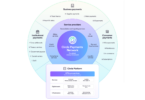Fnality, the London-based company behind the Utility Settlement Coin (USC), has unveiled one of its potential applications. The blockchain-based coin with investment from 15 global financial institutions will be used to instantly settle intraday foreign exchange (FX) swaps using the Finteum platform.
The two firms claim that by combining their platforms, it will create an intraday interbank borrowing system with no settlement risk. However, the joint initiative is still in the early stages.
The costs of intraday liquidity
A 2018 report from Oliver Wyman states that for banks with $100 billion in liquidity reserves, intraday liquidity costs them $100 to $300 million annually. So a 25% reduction in the intraday liquidity requirement could net savings of $25 to $75 million.
Boston Consulting’s (BCG) 2018 Treasury Benchmarking Survey found that intraday working capital for big banks varies from 0.8% to 13.5% of cash balance sheets. And 43% of the questionnaire respondents envisage new intraday products such as intraday swaps, deposits and money market products. Low and behold here’s a solution powered by blockchain.
Fnality & Finteum
Startup Finteum currently operates out of the London offices of enterprise blockchain company R3 and uses the Corda distributed ledger technology (DLT). The pre-seed stage firm was co-founded by Brian Nolan who has spent his career dealing with intraday liquidity in treasury departments at Bank of Ireland and UBS.
“The use case that we’re focused on is intraday borrowing and lending for bank treasurers,” Nolan told Ledger Insights. “And so far they’ve (the banks) told us the financial products they’re most interested in are FX swaps, repos and maybe securities lending, which is very similar to repos.”
The USC is the wholesale digital currency backed by central bank deposits. Initially co-founded by tech startup Clearmatics and UBS, the big backers in its £50 million funding include Nasdaq, UBS, Credit Suisse, Santander, ING and Commerzbank. The currency’s purpose is to enable instant settlement in the form of payment, delivery versus payment or payment versus payment.
“In addition to cost savings, the availability of USC as a payment asset offers new revenue potential to FX trading desks, brokers, and trading platforms,” said Olaf Ransome, Chief Commercial Officer at Fnality. “They will be able to earn returns by lending out cash that they are not using, or by bringing more market liquidity to the future markets in intraday FX swaps”.
How blockchain FX Swaps work
The Fnality and Finteum platforms have distinct roles in the FX Swap with Fnality’s USC handling settlement and Finteum dealing with the intraday FX swap market. The USC leg starts with banks depositing money at a central bank and receiving USC coins. Initially, Fnality will support USD, CAD, GBP, EUR and YEN and expects to launch in 2020.
Finteum is creating a new market. It runs a matching node(s) that receives all the intraday FX swap orders in the market. For an order to be valid and listed, the offering bank has to place the full quantity of USC coins in escrow. Both the unmatched order and escrow can be cancelled.
When an order is matched, say a dollar for sterling swap, the dollar USC from the first bank is exchanged for the sterling USC from the second bank with instant settlement, or payment versus payment (PvP) on the USC platform.
Developers call this an atomic swap because both sides have to happen simultaneously, or not at all. There’s a separate chain for each USC currency. The Clearmatics-designed ION interoperability protocol* enables the sterling and dollar transactions to execute simultaneously on the USC platform on both chains. Additionally, it securely communicates the status to the Finteum platform.
Because the transaction involves atomic PvP, there’s no settlement risk.
What could go wrong?
Once the first leg of the swap is executed, the currency received is unencumbered and can be used elsewhere. After all, the whole purpose is to free up liquidity.
At maturity, when the swap needs to unwind, what happens if the counterparty doesn’t have the swapped USC currency on hand? Nolan said there are multiple design options for that scenario, and they are being discussed with banks and will be floated with central banks and regulators.
Since the first leg involves each bank receiving another currency, the counterparty risk for the return leg of the swap is relatively low. It’s the intraday movement of the currency pair.
The simple solution is intraday margin calls. “If the spot rate moves and a bank is out of the money on an intraday FX swap, we can set it up so that periodically, or once it has hit a certain threshold, we’d place a margin call to the bank that’s out of the money, which they could fulfill with USC in an automated way, or with a few clicks,” said Nolan.
Distributed Central Counterparties
Another potential challenge is when the market locks up. In a crisis, there’s a risk that some banks get frozen out because nobody wants to deal with them. Nolan observed that during the last crisis the FX markets remained reasonably open.
To achieve a robust market, Nolan believes that anonymity is important.
Hence one solution is to involve Central Counterparties (CCPs) and Finteum has already had discussions with multiple CCPs.
But doesn’t a CCP undermine the distributed nature of the network? That could be partially mitigated by having multiple CCPs. However, there’s no avoiding the fact that CCPs demand significant margin and the primary objective of the intraday market is to free up liquidity. The banks must decide whether to pay the cost or face the risk.
“Another design option would be to distribute the responsibility that the CCP takes on when it acts as a central counterparty,” said Nolan. However, he was keen to emphasize that the idea is theoretical.
How would that work? So bank A says it’s willing to face bank B and C. Bank D says it’s prepared to deal with bank B and E. That means Bank A can trade with bank E and does not know the identity of bank E or vice versa. Bank B acts as the counterparty for both sides of the transaction because it’s acceptable to banks A and E. “The trade-off in the design option is that bank B knows both sides,” said Nolan. “You would have to give up information to another participant in the market.”
But again the question is: what happens in a crisis? Wouldn’t the list of acceptable counterparties be short?
“You’d have to have at least two what I’d call ‘sponsors’ in the market,” explained Nolan. “One potential idea is to create a node for the central bank. The central bank should theoretically be willing to face or ‘sponsor’ the commercial banks that are in its jurisdiction.”
Progress
The CCP ideas and options are theoretical at this stage. But the core of the Finteum platform with the USC integration is getting ready for a pilot. Based on existing discussions, Nolan expects to sign up three or four banks to a pilot this year.
Several times during the discussion, Nolan mentioned being at the right place at the right time. Given the demand from banks for intraday liquidity solutions, it looks like that could be the case for both Finteum and Finality.
While the Finteum platform doesn’t yet use ISDA’s common domain model (CDM) for derivatives, Nolan is a fan. “I think the CDM is really powerful and hopefully we will be using it,” said Nolan.
Last year Barclays and ISDA ran a hackathon for the CDM model. This year they are planning a repeat in London, New York and Singapore on 16-17 October with a focus on post-trade processing and securities.
* ION is also intended to make atomic swaps across separate blockchains including those using different technologies where the USC payment may be on one blockchain and the asset on another.






